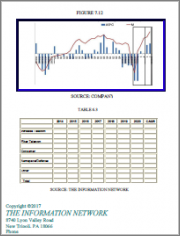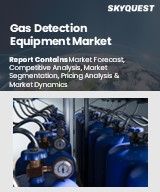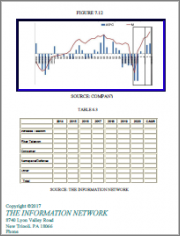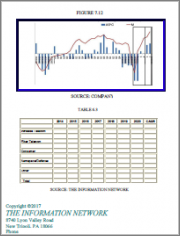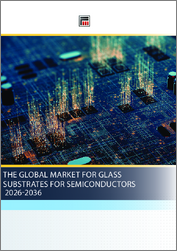
|
시장보고서
상품코드
1826005
세계의 반도체용 유리 기판 시장(2026-2036년)The Global Market for Glass Substrates for Semiconductors 2026-2036 |
||||||
AI, HPC, 차세대 통신 분야의 첨단 패키징 솔루션에 대한 끊임없는 수요에 힘입어 세계의 반도체용 유리 기판 시장은 R&D에서 상업 생산으로 기술이 전환되면서 중요한 변곡점을 맞이하고 있습니다. 유리 기판 시장은 실리콘 인터포저에 비해 비용과 확장성의 이점을 제공하면서 유기 기판의 근본적인 한계를 극복하고 있습니다.
유리 기판은 첨단 칩 패키지의 유기 코어를 대체하여 우수한 치수 안정성, 낮은 유전체 손실, 멀티 칩렛 아키텍처에 필수적인 대형화 능력을 제공합니다. 이 기술을 통해 제조업체는 극한의 온도 범위(-40℃-150℃)에서도 열적, 전기적 성능을 유지하면서 방대한 I/O 수를 지원하는 2마이크로미터 이하의 재분배 레이어 지오메트리를 구현할 수 있습니다. 주요 장점으로는 55mm를 초과하면 치수가 불안정한 유기 대체품에 비해 신호 무결성에서 40%의 성능 향상, 50%의 전력 소비 감소, 뛰어난 평탄도(100mm 패키지에서 20마이크로미터 미만의 휨)를 들 수 있습니다.
TGV(Through-Glass Via) 기술은 중요한 원동력이며, 레이저 수정과 습식 에칭을 결합한 레이저 유도 딥 에칭(LIDE), 직접 레이저 절제, 감광성 유리법 등 여러 가지 형성 접근법이 경쟁하고 있습니다. 최근 시연에서는 종횡비가 15:1을 초과하는 직경 6마이크로미터의 비아를 사용하여 디스플레이 산업의 유산인 패널 스케일 처리를 지원하는 고밀도 수직 상호연결이 가능해졌습니다.
시장은 응용 분야가 고도로 세분화되어 있습니다. AI와 HPC는 유리 기판을 통해 HBM 메모리 스택과 8-16개의 칩렛을 통합한 60-80mm 패키지로 구현할 수 있으며, 휘어진 유기 기판에서는 불가능한 아키텍처입니다. 51.2-102.4Tbps의 총 대역폭을 필요로 하는 데이터센터 스위치에서는 전기적 상호연결과 함께 집적 광도파관용 유리 투명성을 활용한 CPO(Co-Packaged Optics) 아키텍처의 채택이 증가하고 있습니다.
통신 인프라, 특히 100-300GHz 주파수에서 동작하는 5G Massive MIMO와 신흥 6G 시스템은 유기 기판의 전기적 손실이 부족한 또 다른 유력한 분야입니다. 자동차 애플리케이션, 특히 ADAS 및 자율주행 플랫폼용 77-81GHz 레이더는 극한의 온도 환경에서도 빔의 일관성을 유지하는 유리의 위상 안정성의 이점을 누릴 수 있습니다. 소비자 전자제품의 채택은 5G 밀리미터파 스마트폰, AR/VR 헤드셋, 게임 시스템과 같은 프리미엄 부문에 집중되어 있으며, 이러한 부문에서는 성능 차별화를 통해 초기 상용화 단계의 할증료를 정당화할 수 있습니다. Apple, Tesla, AMD, AMD, Amazon AWS 등 주요 기술 기업들이 인증 시험을 진행하고 있으며, Samsung Electronics는 2028년까지 유리 기판 인터포저를 도입할 계획이며, 세종 시설에서 파일럿 라인을 가동하고 있습니다.
Intel이 전략적 축을 사내 생산에서 광범위한 특허 포트폴리오(Intel's strategic axis from in-house production to extensive patent portfolio(600건 이상의 유리 기판 특허)의 라이선싱으로 전환함으로써 후발업체들이 보다 빠르게 개발을 진행할 수 있게 되어 산업 전체의 상용화가 가속화될 가능성이 있습니다. Samsung Electro-Mechanics는 2025년 2분기까지 첫 시제품 생산을 목표로 하고 있으며, LG Innotek은 연말 프로토타입 생산을 목표로 구미의 파일럿 라인을 건설하고 있습니다. AGC, Corning, SCHOTT, Nippon Electric Glass 등의 유리 재료 공급업체는 CTE 정합 및 저유전 손실에 최적화된 기판 등급 구성을 제공합니다.
매력적인 장점에도 불구하고 유리 기판은 큰 채택 장벽에 직면하고 있습니다. 현재 비용은 유기 대비 2-3배에 달하고, 생산 수율은 유기 기판의 90-95%에 비해 75-85%에 불과하며, 공급망 집중으로 인해 단일 공급원에 의존하게 됩니다. 취성은 특별한 핸들링 자동화가 필요하며, TGV 성형 및 미세 피치 RDL 공정은 지속적인 최적화가 필요합니다. 특히 자동차나 통신과 같은 보수적인 산업에서는 18-36개월에 이르는 고객 인증 주기가 시장 진입을 지연시킵니다.
세계의 반도체용 유리 기판 시장에 대해 조사 분석했으며, 시장 규모와 예측, 투자 전망 및 채용 시나리오, 과제와 기회, 가치사슬 전반의 기업 프로파일 등의 정보를 전해드립니다.
목차
제1장 주요 요약
- 유리 소재 개요
- 반도체의 유리 응용
- 첨단 패키징용 유리
- 기술적 촉진요인과 재료의 우위
- 공급망 진화 및 제조 준비도
- 응용 분야 및 시장 역학
- 경쟁 상황과 전략적 포지셔닝
- 기술적 과제와 위험요소
- 투자 및 채용 전망
- 다양한 반도체 용도에 사용되는 유리
- 유리 패키징의 기회
- 유리 기판의 장점
- 유리 기판 채택의 과제
- 향후 시장 동향
- 유리 기판의 밸류체인
- 향후 전망
- 소재 혁신
- 세계 시장 예측(2025-2036년)
제2장 유리 기판 기술의 기초
- 유리 소재의 특성
- 제조 공정
- 설계 및 프로세스 고려사항
제3장 첨단 패키징과 IC 기판에서의 유리
- 첨단 패키징의 진화
- 패키징 아키텍처 및 통합
- 유리 IC 기판의 진화
- TGV(Through Glass Via) 기술
- TGV 금속화 및 가공
- 재료의 특성과 성능
- 기존 기판의 한계
- 유리 코어 기판 기술
- 유리 기판 제조
- 첨단 제조 공정
- 산업 구현 및 혁신
제4장 포토닉스에서의 유리
- 광학적 통합
- CPO(Co-Packaged Optics)
- 유리 도파관 기술
- 제조 및 통합 프로세스
제5장 고주파 응용 분야에서의 유리
- 고주파 재료 요구 사항
- 재료 벤치마크 및 성능
- 유리 공급업체 및 제품
- RF 응용 및 구현
제6장 기술 벤치마크와 비교
- 유리 vs. 유기 기판
- 유리 인터포저 vs. 실리콘 인터포저
- 하이브리드 기판
- 미래 기술 로드맵
제7장 최종사용자 시장 분석
- AI·HPC
- 데이터센터 및 클라우드 컴퓨팅
- 통신·5G/6G
- 카 일렉트로닉스
- 소비자 가전
제8장 과제와 기회
- 기술적 과제
- 경제와 시장의 과제
- 전략적 기회
제9장 향후 전망
- 기술 진화 예측
- 시장 발전 시나리오
제10장 기업 프로파일
- 3D CHIPS
- 3D Glass Solutions(3DGS)
- Absolics(SKC)
- Advanced Semiconductor Engineering(ASE)
- AGC Inc.(formerly Asahi Glass)
- Ajinomoto Co., Inc.
- Alliance Material
- AMD(Advanced Micro Devices)
- Applied Materials, Inc.
- AT&S Austria Technologie & Systemtechnik AG
- BOE
- Chengdu ECHINT(Echoing Electronics)
- Corning Incorporated
- DNP(Dai Nippon Printing Co., Ltd.)
- Guangdong Fozhixin Microelectronics
- Ibiden
- Intel Corporation
- JNTC Co., Ltd.
- KCC Corporation
- LG Innotek
- LPKF Laser & Electronics
- Nippon Electric Glass(NEG)
- NVIDIA Corporation
- Onto Innovation
- Philoptics
- Plan Optik AG
- RENA Technologies GmbH
- Samsung Electro-Mechanics(Semco)
- Samtec Inc.
- SCHOTT AG
- Shinko
- Sky Semiconductor
- Sumitomo Electric Industries, Ltd.
- Toppan
- TSMC(Taiwan Semiconductor Manufacturing Company)
- Unimicron Technology Corporation
- WG Tech(Wuxi Gaojing Technology)
제11장 부록
제12장 참고 문헌
KSM 25.10.30The global market for glass substrates in semiconductor applications is experiencing a critical inflection point as the technology transitions from research and development to commercial production, driven by insatiable demand for advanced packaging solutions in AI, high-performance computing, and next-generation communications. The glass substrate market addresses fundamental limitations of organic substrates while offering cost and scalability advantages over silicon interposers.
Glass substrates replace organic cores in advanced chip packages, providing superior dimensional stability, lower dielectric loss, and larger format capabilities essential for multi-chiplet architectures. The technology enables manufacturers to achieve sub-2micrometer redistribution layer geometries, supporting massive I/O counts (10,000-50,000 per package) while maintaining thermal and electrical performance across extreme temperature ranges (-40degree-C to 150degree-C). Key advantages include 40% performance improvements in signal integrity, 50% power consumption reduction, and exceptional flatness (<20micrometer warpage across 100mm packages) compared to organic alternatives that suffer dimensional instability beyond 55mm.
Through-glass via (TGV) technology represents the critical enabler, with multiple formation approaches competing: laser-induced deep etching (LIDE) combining laser modification with wet etching, direct laser ablation, and photosensitive glass methods. Recent demonstrations show 6micrometer diameter vias with aspect ratios exceeding 15:1, enabling high-density vertical interconnection supporting panel-scale processing from display industry heritage.
The market exhibits sophisticated segmentation across application domains. AI and high-performance computing represent the largest near-term opportunity, with glass substrates enabling 60-80mm packages integrating 8-16 chiplets with HBM memory stacks-architectures impossible with warped organic substrates. Data center switches requiring 51.2-102.4 Tbps aggregate bandwidth increasingly adopt co-packaged optics (CPO) architectures that leverage glass transparency for integrated optical waveguides alongside electrical interconnection.
Telecommunications infrastructure, particularly 5G massive MIMO and emerging 6G systems operating at 100-300 GHz frequencies, represents another compelling segment where organic substrates' electrical losses render them inadequate. Automotive applications, especially 77-81 GHz radar for ADAS and autonomous driving platforms, benefit from glass's phase stability maintaining beam coherence across temperature extremes. Consumer electronics adoption concentrates in premium segments-5G millimeter-wave smartphones, AR/VR headsets, and gaming systems-where performance differentiation justifies cost premiums during early commercialization. Major technology companies including Apple, Tesla, AMD, and Amazon AWS are conducting qualification testing, with Samsung Electronics planning glass substrate interposer adoption by 2028 and operating pilot lines at Sejong facilities.
Intel's strategic pivot from internal production to licensing its extensive patent portfolio (600+ glass substrate patents) could accelerate industry-wide commercialization by enabling latecomers to advance development more rapidly. Samsung Electro-Mechanics targets first prototypes by Q2 2025, while LG Innotek builds Gumi pilot lines aiming for year-end prototype production. Glass material suppliers including AGC, Corning, SCHOTT, and Nippon Electric Glass provide substrate-grade compositions optimized for CTE matching and low dielectric loss.
Despite compelling advantages, glass substrates face significant adoption barriers: current costs run 2-3x organic equivalents, manufacturing yields remain at 75-85% versus organic substrates' 90-95%, and supply chain concentration creates single-source dependencies. Brittleness requires specialized handling automation, while TGV formation and fine-pitch RDL processes demand continued optimization. Customer qualification cycles spanning 18-36 months delay market entry, particularly in conservative industries like automotive and telecommunications.
However, aggressive cost reduction roadmaps project 40-60% declines by 2030 through manufacturing scale, yield improvements, and competitive supply emergence. As processes mature and ecosystem infrastructure develops-design tools, standards, contract manufacturing services-glass substrates are positioned to capture 20-30% of advanced packaging market by 2036, with deployment timelines accelerating as major technology companies validate commercial viability through pilot programs transitioning to volume production in 2027-2030 timeframe.
"The Global Market for Glass Substrates for Semiconductors 2026-2036" delivers comprehensive analysis of this transformative advanced packaging technology poised to revolutionize semiconductor manufacturing. As AI accelerators, 5G/6G infrastructure, and autonomous vehicles demand unprecedented integration density and electrical performance, glass substrates emerge as the critical enabling platform displacing conventional organic substrates and challenging silicon interposers across high-performance applications.
Report Contents include:
- Comprehensive market overview with global forecasts 2026-2036 (revenue and volume)
- Glass materials fundamentals and applications across semiconductor packaging
- Technology drivers: dimensional stability, low dielectric loss, panel-scale processing
- Supply chain evolution from pilot production to mainstream adoption
- Application segment analysis: advanced packaging, photonic integration, high-frequency RF
- Competitive landscape assessment covering 37+ companies
- Technical challenges and risk mitigation strategies
- Investment outlook and adoption scenarios
- Detailed unit shipment and market value forecasts by product category (carriers, core substrates, interposers)
- Glass Substrates Technology Fundamentals
- Material properties: borosilicate, quartz, specialty compositions with comparison matrices
- Manufacturing processes: glass forming, TGV formation methods, metallization, panel-level processing
- Design considerations: thermal management, mechanical stress analysis, electrical performance optimization
- Glass in Advanced Packaging and IC Substrates
- Advanced packaging evolution from 1D through 4D integration architectures
- Intel's advanced packaging roadmap and heterogeneous integration solutions
- Glass IC substrates evolution and organic-to-glass transition pathway
- Through-glass via technology comprehensive analysis with vendor-specific approaches
- TGV metallization processes and comparison matrices
- Material properties and I/O density advantages
- Traditional substrate limitations driving glass adoption
- Glass substrate manufacturing processes including CHIMES innovations
- Intel's glass production line capabilities
- Glass in Photonics
- Photonic integration overview and optical coupling strategies
- Co-packaged optics (CPO) comprehensive analysis and architecture options
- Glass waveguide technologies: ion exchange, fiber coupling, signal routing
- Corning's 102.4 Tb/s platform and 3D integration demonstrations
- Glass in High-Frequency Applications
- High-frequency material requirements and transmission loss analysis
- Material benchmarking: LTCC versus glass comparisons
- Glass suppliers and products directory
- RF applications: filters, IPD, antenna-in-package for 5G/6G
- Technology Benchmarking and Comparison
- Glass versus organic substrates: performance, cost, manufacturing, application suitability
- Glass versus silicon interposers: technical metrics, economics, scalability
- Hybrid substrates analysis and cost-performance trade-offs
- Future technology roadmaps: materials, processes, integration complexity, performance projections
- End-User Market Analysis
- AI and high-performance computing: market sizing, requirements, key players, development trends
- Data centers and cloud computing: infrastructure demands, adoption patterns, opportunity assessment
- Telecommunications and 5G/6G: network evolution, RF requirements, integration challenges
- Automotive electronics: ADAS, electric vehicles, autonomous platforms, reliability requirements
- Consumer electronics: mobile devices, wearables, gaming systems
- Challenges and Opportunities
- Technical challenges: manufacturing maturity, yield issues, design complexity, standardization
- Economic challenges: cost competitiveness, investment requirements, customer adoption barriers
- Strategic opportunities: performance differentiation, new applications, technology convergence
- Future Outlook
- Technology evolution projections: next-generation materials, advanced manufacturing, integration advances
- Performance enhancement roadmap through 2036
- Market development scenarios: optimistic, conservative, and disruptive technology impacts
- 37 detailed company profiles spanning entire value chain with technology positioning, products, capabilities, and strategy including Absolics (SKC subsidiary), Intel Corporation, Samsung Electro-Mechanics (Semco), LG Innotek, AGC Inc., Corning Incorporated, SCHOTT AG, Nippon Electric Glass (NEG), LPKF Laser & Electronics, Applied Materials, Onto Innovation, AMD, NVIDIA, TSMC, Ibiden, Shinko, Unimicron Technology Corporation, AT&S Austria Technologie & Systemtechnik AG, Toppan, Advanced Semiconductor Engineering (ASE), Plan Optik AG, JNTC Co. Ltd., KCC Corporation, RENA Technologies GmbH, Philoptics, Samtec Inc., BOE, Chengdu ECHINT, Guangdong Fozhixin Microelectronics, Sky Semiconductor, WG Tech, Ajinomoto Co. Inc., DNP (Dai Nippon Printing), Alliance Material, 3D CHIPS, 3D Glass Solutions (3DGS), and Sumitomo Electric Industries Ltd. Each profile examines corporate strategy, technology positioning, product offerings, manufacturing capabilities, and competitive advantages within the rapidly evolving glass substrate ecosystem.
TABLE OF CONTENTS
1. EXECUTIVE SUMMARY
- 1.1. Glass Materials Overview
- 1.2. Applications of Glass in Semiconductors
- 1.3. Glass for Advanced Packaging
- 1.4. Technological Drivers and Material Advantages
- 1.5. Supply Chain Evolution and Manufacturing Readiness
- 1.6. Application Segments and Market Dynamics
- 1.6.1. Advanced Packaging and IC Substrates
- 1.6.2. Photonic Integration
- 1.6.3. High-Frequency Applications
- 1.7. Competitive Landscape and Strategic Positioning
- 1.8. Technical Challenges and Risk Factors
- 1.9. Investment and Adoption Outlook
- 1.10. Glass Used in Various Semiconductor Applications
- 1.11. Opportunities with Glass Packaging
- 1.12. Advantages of Glass Substrates
- 1.13. Challenges in Adopting Glass Substrates
- 1.14. Future Market Trends
- 1.14.1. Advanced Processing Technologies
- 1.14.2. Integrated Packaging Solutions & Sustainable Manufacturing Initiatives
- 1.15. Value Chain of Glass Substrate
- 1.15.1. Organic to Glass Core Substrate
- 1.16. Future Outlook
- 1.17. Material Innovations
- 1.18. Global Market Forecasts 2025-2036
- 1.18.1. Unit Shipment Forecast 2025-2036
- 1.18.1.1. Glass Carrier Shipments
- 1.18.1.2. Glass Core Substrate Shipments
- 1.18.1.3. Glass Interposer Shipments
- 1.18.2. Market Value Forecast 2025-2036
- 1.18.2.1. Glass Carrier Market Value
- 1.18.2.2. Glass Core Substrate Market Value
- 1.18.2.3. Glass Interposer Market Value
- 1.18.1. Unit Shipment Forecast 2025-2036
2. GLASS SUBSTRATES TECHNOLOGY FUNDAMENTALS
- 2.1. Glass Materials Properties
- 2.1.1. Borosilicate Glass Characteristics
- 2.1.2. Quartz Glass Properties
- 2.1.3. Specialty Glass Compositions
- 2.2. Manufacturing Processes
- 2.2.1. Glass Melting and Forming
- 2.2.2. Through Glass Via (TGV) Formation
- 2.2.3. Metallization and Build-up Processes
- 2.2.4. Panel-Level Processing Technologies
- 2.3. Design and Process Considerations
- 2.3.1. Thermal Management
- 2.3.2. Mechanical Stress Analysis
- 2.3.3. Electrical Performance Optimization
3. GLASS IN ADVANCED PACKAGING AND IC SUBSTRATES
- 3.1. Advanced Packaging Evolution
- 3.1.1. Dimensionality of Advanced Packaging
- 3.1.2. From 1D Semiconductor Packaging
- 3.1.3. Advanced Packaging 2D & 2D+
- 3.1.4. Advanced Packaging 2.5D & 3D
- 3.1.5. Advanced Packaging 3.5D & 4D
- 3.1.6. Technology Development Trend for 2.5D and 3D Packaging
- 3.2. Packaging Architecture and Integration
- 3.2.1. Intel's Advanced Packaging Roadmap
- 3.2.2. Heterogeneous Integration Solutions
- 3.2.3. Overview of System on Chip (SOC)
- 3.2.4. Overview of Multi-Chip Module (MCM)
- 3.2.5. System in Package (SiP)
- 3.3. Glass IC Substrates Evolution
- 3.3.1. Glass IC Substrates
- 3.3.2. From Organic to Glass Core Substrate
- 3.3.3. Evolution of Packaging Substrates in Semiconductors
- 3.3.4. Organic Core Substrate vs. Glass Core Substrate
- 3.4. Through Glass Via Technology
- 3.4.1. TSV vs. TGV
- 3.4.2. Through Glass Via Formation
- 3.4.3. Comparison of Through Glass Via Formation Processes
- 3.4.4. TGV Process and Via Formation Methods
- 3.4.5. Mechanical and High-Power Laser Drilling
- 3.4.6. Laser-Induced Deep Etching
- 3.4.7. LMCE from BSP
- 3.4.8. Philoptics' TGV Technology
- 3.4.9. Laser-Induced Modification and Advanced Wet Etching
- 3.4.10. Photosensitive Glass and Wet Etching
- 3.4.11. Samtec's TGV Technology
- 3.4.12. TGV of High Aspect Ratio
- 3.5. TGV Metallization and Processing
- 3.5.1. TGV Metallization
- 3.5.2. Two-Step Process
- 3.5.3. Seed Layer Deposition in TGV Metallization
- 3.6. Material Properties and Performance
- 3.6.1. Material Property Comparison for Advanced Packaging
- 3.6.2. Key Mechanical and Reliability Benefits of Glass
- 3.6.3. I/O Density
- 3.6.4. Key Factors Enabling Fine Circuit Patterns on Glass Substrates
- 3.6.5. Fine Circuit Patterning Reduces DoF
- 3.6.6. FC-BGA Substrates Lead to Larger Distortions
- 3.7. Traditional Substrate Limitations
- 3.7.1. Limitations of Via Formation
- 3.7.2. SAP Method Limitations
- 3.7.3. PCB Stack-ups
- 3.7.4. Traditional Multilayer vs. Build-up PCBs
- 3.7.5. Build-up Material: ABF
- 3.7.6. Flip Chip Ball Grid Array (FC-BGA) Substrate
- 3.8. Glass Core Substrate Technologies
- 3.9. Glass Substrate Manufacturing
- 3.9.1. Glass Substrate Manufacturing
- 3.9.2. Core Layer Fabrication
- 3.9.3. Build-up Layer Fabrication
- 3.9.4. Manufacturing Process of Glass Substrate (CHIMES)
- 3.9.5. Achieving 2/2 micrometer L/S on Glass Substrate
- 3.10. Advanced Manufacturing Processes
- 3.10.1. Intel's Glass Line
- 3.11. Industry Implementation and Innovation
- 3.11.1. Features of Glass-based Advanced Packaging and IC Substrates
- 3.11.2. Advanced Thermal Management for Glass Packages
- 3.11.3. Glass Innovation
4. GLASS IN PHOTONICS
- 4.1. Photonic Integration
- 4.1.1. Overview
- 4.1.2. Optical Coupling - I/O
- 4.1.3. EIC/PIC Integration
- 4.2. Co-Packaged Optics
- 4.2.1. Co-Packaged Optics
- 4.2.2. Key Trend of Optical Transceiver
- 4.2.3. Glass-Based CPO Integration
- 4.3. Glass Waveguide Technologies
- 4.3.1. Ion Exchange Waveguide Formation Technology
- 4.3.2. Adiabatic Glass-to-Silicon Waveguide Coupling for CPO Integration
- 4.3.3. Glass-Based Fiber Connector Assembly for CPO Applications
- 4.4. Manufacturing and Integration Processes
- 4.4.1. Glass Interposer Manufacturing Process and Laser Separation Technology
- 4.4.2. Corning's High-Density 102.4 Tb/s Glass Integration Platform
- 4.4.3. 3D Integration of EIC/PIC with a Glass Interposer
- 4.4.4. 3D Integration of EIC, PIC, ASIC on a Co-Packaged Glass Substrate
- 4.4.5. Fabrication Process of the 3D Integration of ASIC, EIC, PIC on a Co-Packaged Substrate
- 4.4.6. Advancements in Glass Integration for Photonics
5. GLASS IN HIGH-FREQUENCY APPLICATIONS
- 5.1. High-Frequency Material Requirements
- 5.1.1. Applications of Low-Loss Materials in Semiconductor and Electronics Packaging
- 5.1.2. Transmission Loss in High-Frequency PCB Design
- 5.1.3. Glass as a Low-Loss Material
- 5.2. Material Benchmarking and Performance
- 5.2.1. Benchmark of LTCC and Glass Materials
- 5.2.2. Dielectric Constant: Stability vs Frequency for Different Inorganic Substrates (LTCC, Glass)
- 5.2.3. Benchmarking of Commercial Low-Loss Materials for 5G PCBs/Components
- 5.3. Glass Suppliers and Products
- 5.4. RF Applications and Implementations
- 5.4.1. Glass as a Filter Substrate
- 5.4.2. Glass Integrated Passive Devices (IPD) Filter for 5G by Advanced Semiconductor Engineering
- 5.4.3. Glass Substrate AiP for 5G
- 5.4.4. Glass for 6G
- 5.4.5. Glass Interposers for 6G
6. TECHNOLOGY BENCHMARKING AND COMPARISON
- 6.1. Glass vs Organic Substrates
- 6.1.1. Performance Comparison
- 6.1.2. Cost Analysis
- 6.1.3. Manufacturing Considerations
- 6.1.4. Application Suitability
- 6.2. Glass vs Silicon Interposers
- 6.2.1. Technical Performance Metrics
- 6.2.2. Economic Comparison
- 6.2.3. Scalability Assessment
- 6.3. Hybrid Substrates
- 6.3.1. Glass-Organic Hybrid Designs
- 6.3.2. Multi-Material Integration
- 6.3.3. Performance Optimization
- 6.3.4. Cost-Performance Trade-offs
- 6.4. Future Technology Roadmaps
- 6.4.1. Material Innovation Trends
- 6.4.2. Process Technology Evolution
- 6.4.3. Integration Complexity Growth
- 6.4.4. Performance Projection Models
7. END-USER MARKET ANALYSIS
- 7.1. AI and High-Performance Computing
- 7.1.1. Market Size and Growth Drivers
- 7.1.2. Technology Requirements
- 7.1.3. Key Players and Products
- 7.1.4. Future Development Trends
- 7.2. Data Centers and Cloud Computing
- 7.2.1. Infrastructure Scaling Demands
- 7.2.2. Performance and Efficiency Requirements
- 7.2.3. Technology Adoption Patterns
- 7.2.4. Market Opportunity Assessment
- 7.3. Telecommunications and 5G/6G
- 7.3.1. Network Infrastructure Evolution
- 7.3.2. RF Component Requirements
- 7.3.3. Technology Integration Challenges
- 7.4. Automotive Electronics
- 7.4.1. Advanced Driver Assistance Systems
- 7.4.2. Electric Vehicle Electronics
- 7.4.3. Autonomous Driving Platforms
- 7.4.4. Reliability and Safety Requirements
- 7.5. Consumer Electronics
- 7.5.1. Mobile Device Applications
- 7.5.2. Wearable Technology Integration
- 7.5.3. Gaming and Entertainment Systems
8. CHALLENGES AND OPPORTUNITIES
- 8.1. Technical Challenges
- 8.1.1. Manufacturing Process Maturity
- 8.1.2. Yield and Reliability Issues
- 8.1.3. Design and Integration Complexity
- 8.1.4. Standardization Requirements
- 8.2. Economic and Market Challenges
- 8.2.1. Cost Competitiveness
- 8.2.2. Investment Requirements
- 8.2.3. Customer Adoption Barriers
- 8.3. Strategic Opportunities
- 8.3.1. Performance Differentiation
- 8.3.2. New Application Development
- 8.3.3. Technology Convergence Benefits
9. FUTURE OUTLOOK
- 9.1. Technology Evolution Projections
- 9.1.1. Next-Generation Material Developments
- 9.1.2. Advanced Manufacturing Processes
- 9.1.3. Integration Technology Advances
- 9.1.4. Performance Enhancement Roadmap
- 9.2. Market Development Scenarios
- 9.2.1. Optimistic Growth Scenario
- 9.2.2. Conservative Growth Scenario
- 9.2.3. Disruptive Technology Impact
10. COMPANY PROFILES
- 10.1. 3D CHIPS
- 10.2. 3D Glass Solutions (3DGS)
- 10.3. Absolics (SKC)
- 10.4. Advanced Semiconductor Engineering (ASE)
- 10.5. AGC Inc. (formerly Asahi Glass)
- 10.6. Ajinomoto Co., Inc.
- 10.7. Alliance Material
- 10.8. AMD (Advanced Micro Devices)
- 10.9. Applied Materials, Inc.
- 10.10. AT&S Austria Technologie & Systemtechnik AG
- 10.11. BOE
- 10.12. Chengdu ECHINT (Echoing Electronics)
- 10.13. Corning Incorporated
- 10.14. DNP (Dai Nippon Printing Co., Ltd.)
- 10.15. Guangdong Fozhixin Microelectronics
- 10.16. Ibiden
- 10.17. Intel Corporation
- 10.18. JNTC Co., Ltd.
- 10.19. KCC Corporation
- 10.20. LG Innotek
- 10.21. LPKF Laser & Electronics
- 10.22. Nippon Electric Glass (NEG)
- 10.23. NVIDIA Corporation
- 10.24. Onto Innovation
- 10.25. Philoptics
- 10.26. Plan Optik AG
- 10.27. RENA Technologies GmbH
- 10.28. Samsung Electro-Mechanics (Semco)
- 10.29. Samtec Inc.
- 10.30. SCHOTT AG
- 10.31. Shinko
- 10.32. Sky Semiconductor
- 10.33. Sumitomo Electric Industries, Ltd.
- 10.34. Toppan
- 10.35. TSMC (Taiwan Semiconductor Manufacturing Company)
- 10.36. Unimicron Technology Corporation
- 10.37. WG Tech (Wuxi Gaojing Technology)
11. APPENDICES
- 11.1. Technical Glossary and Definitions
- 11.2. Technology Evolution Timeline
- 11.3. Research Approach and Framework
- 11.3.1. Research Objectives
- 11.3.2. Research Methodology Overview
- 11.3.2.1. Primary Research Methods
- 11.3.2.2. Secondary Research Methods







